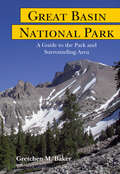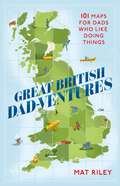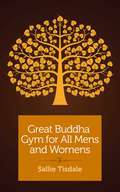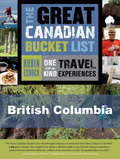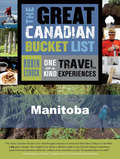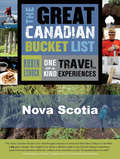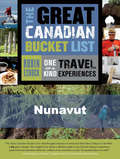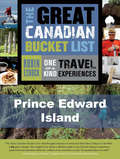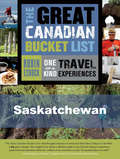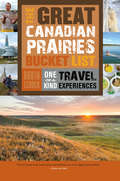- Table View
- List View
The Great Atlantic Canada Bucket List: One-of-a-Kind Travel Experiences
by Robin EsrockMost Canadians think of travel as a way to escape the snow, cold, and dreary winter skies. But Robin Esrock loves all that our eastern provinces have to offer visitors, and so will you! The Great Atlantic Canada Bucket List highlights the best travel experiences to be had on Canada’s East Coast. Not your typical travel guide, Robin’s recommendations encompass outdoor adventure and natural wonders as well as the unique food, culture, and history of the Maritimes. Categorized by province, The Great Atlantic Canada Bucket List will give you a first-hand perspective on: • Ziplining over a waterfall in New Brunswick. • Harvesting an iceberg for a Newfoundland cocktail. • Exploring Nova Scotia’s Cabot Trail. • Walking the seabed beneath Hopewell Rocks. • Cycling across Canada’s island province. • Rafting a tidal wave in the Bay of Fundy.
Great Basin National Park: A Guide to the Park and Surrounding Area (G - Reference, Information And Interdisciplinary Subjects Ser.)
by Gretchen M. BakerGreat Basin National Park is in large part a high-alpine park, but it sits in one of America’s driest, least populated, and most isolated deserts. That contrast is one facet of the diversity that characterizes this region. Within and outside the park are phenomenal landscape features, biotic wonders, unique environments, varied historic sites, and the local colors of isolated towns and ranches. Vast Snake and Spring Valleys, bracketing the national park, are also subjects of one of the West's most divisive environment contests, over what on the surface seems most absent but underground is abundant enough for sprawling Las Vegas to covet it—water.
Great Basin National Park
by Gretchen M. BakerGreat Basin National Park, Snake Valley, and Spring Valley cover more than 3,000 square miles across portions of Nevada and Utah, but few people know much about this diverse area. In her guidebook to Great Basin National Park, Gretchen Baker covers everything a potential visitor needs to know about one of the country's best-kept secrets.The park sits in one of America's driest, least populated, and most isolated deserts. It is a place of significant geological and scenic value, offering unspoiled vistas, abundant wildlife, clean air, and natural attractions. That contrast is one facet of the diversity that characterizes this region. Within and outside the park are phenomenal landscape features, biotic wonders, unique environments, varied historic sites, and the local colors of isolated towns and ranches. Vast Snake and Spring Valleys, bracketing the national park, are also subjects of one of the West's most divisive environmental contests. At stake is what on the surface seems almost absent but underground is abundant enough for sprawling Las Vegas to covet--water.This guidebook not only describes the peaks, glaciers, subalpine lakes, caves, hiking trails, campgrounds, and historical sites but also explores the cultural history of the park and surrounding area. Each chapter addresses the physical attributes and navigational issues of a specific area and includes an in-depth historical overview. The text is complemented by useful maps and historical photographs and makes Great Basin National Park: A Guidebook to the Park and Surrounding Area the most comprehensive book on the region available.It will be essential to naturalists, historians, and tourists interested in exploring the attractions, natural history, and cultural history of the Great Basin.
Great British Dad-ventures: 101 maps for dads who like doing things
by Mat RileyWATERSTONES' BEST BOOKS OF THE YEAR 2023: NATURE AND TRAVELWhen you're stuck for a great gift for Dad, look no further than GREAT BRITISH DADVENTURES: the ultimate guide to helping Dad discover adrenaline-inducing, mind-expanding or stomach-pleasing mini or big adventures around the British Isles - and families of all ages can join in the fun too!Using maps of all the Scottish and English counties and the Welsh principal areas, the book pinpoints almost 1,000 destinations and activities, including plenty of free and baby-friendly options (and a few that are for Dad's friends only). Whether he's looking for something interesting to do nearby at the weekend or heading off on holiday around our vast and varied British Isles, GREAT BRITISH DAD-VENTURES has all the inspiration Dad needs to get off his screen and do something exciting. Activities include: - walks, hikes, cycling and mountain biking - castles and museums - watersports, wild swimming and boat trips - nature reserves and safari parks - orienteering and bushcraft experiences - scenic driving routes and walking tours - climbing, coasteering and gorge walking - brewery and vineyard tours - and plenty of activities that are unique to the local areas.
Great British Dad-ventures: 101 maps for dads who like doing things
by Mat RileyWATERSTONES' BEST BOOKS OF THE YEAR 2023: NATURE AND TRAVELWhen you're stuck for a great gift for Dad, look no further than GREAT BRITISH DADVENTURES: the ultimate guide to helping Dad discover adrenaline-inducing, mind-expanding or stomach-pleasing mini or big adventures around the British Isles - and families of all ages can join in the fun too!Using maps of all the Scottish and English counties and the Welsh principal areas, the book pinpoints almost 1,000 destinations and activities, including plenty of free and baby-friendly options (and a few that are for Dad's friends only). Whether he's looking for something interesting to do nearby at the weekend or heading off on holiday around our vast and varied British Isles, GREAT BRITISH DAD-VENTURES has all the inspiration Dad needs to get off his screen and do something exciting. Activities include: - walks, hikes, cycling and mountain biking - castles and museums - watersports, wild swimming and boat trips - nature reserves and safari parks - orienteering and bushcraft experiences - scenic driving routes and walking tours - climbing, coasteering and gorge walking - brewery and vineyard tours - and plenty of activities that are unique to the local areas.
Great British Journeys
by Nicholas CraneIntrepid presenter Nicholas Crane investigates eight epic journeys, following in the footsteps of our greatest indigenous explorers.Nick presents eight of the most interesting traveller-chroniclers to have explored and reported on the state of the nation. From Gerald of Wales who embarked on a seven week journey around the wild perimeter of Wales in March 1188, to HV Morton, the journalist and travel writer who crossed the length and breadth of England by car in the 1920s. Others include Celia Fiennes who started her many journeys around Britain on horseback in the late 1600s at the age of 20, Tudor antiquarian John Leland, Daniel Defoe, William Cobbett, Thomas Pennant, and William Gilpin, who travelled through the north of England by boat in 1770.
Great British Journeys
by Nicholas CraneIntrepid presenter Nicholas Crane investigates eight epic journeys, following in the footsteps of our greatest indigenous explorers.Nick presents eight of the most interesting traveller-chroniclers to have explored and reported on the state of the nation. From Gerald of Wales who embarked on a seven week journey around the wild perimeter of Wales in March 1188, to HV Morton, the journalist and travel writer who crossed the length and breadth of England by car in the 1920s. Others include Celia Fiennes who started her many journeys around Britain on horseback in the late 1600s at the age of 20, Tudor antiquarian John Leland, Daniel Defoe, William Cobbett, Thomas Pennant, and William Gilpin, who travelled through the north of England by boat in 1770.
Great Buddha Gym for All Mens and Womens
by Sallie TisdaleIn Great Buddha Gym for All Mens and Womens, author Sallie Tisdale so richly evokes her pilgrimage to the four vital sites related to Buddha Shakyamuni&’s life and enlightenment that the reader feels as if she&’s tripping alongside Tisdale every crowded, colorful, and sensuous step of the way. The challenges of travel in modern India are daunting. The ancient sites are overrun with tourists and seekers. Merchants hawking spiritual goods are everywhere. And yet, miraculously, despite the chaos, the great teachings of the Buddha come shining through.
The Great Canadian Bucket List: One-of-a-Kind Travel Experiences
by Robin EsrockA National Bestseller! Fully revised with new chapters and fascinating destinations to explore, renowned travel writer Robin Esrock guides you to Canada’s most incredible experiences. Having visited more than 100 countries on 7 continents, Robin Esrock has built a career chasing the extraordinary. His bestselling Bucket List books feature experiences that are entirely unique, instantly memorable, wholly inspirational, and available to all. Celebrating his adopted home of Canada, Robin journeys to every province and territory to reveal the remarkable activities and destinations that are unique to the True North strong and free. Get ready to: Cross the mythical Northwest Passage Cycle across Prince Edward Island Float on Canada’s very own Dead Sea Feel the hot breath of a wild polar bear Cave bash along Quebec’s Magdalen Islands Sail among whales in the “Galapagos of the North” Taste Canada’s best poutine, smoked meat, and fish and chips Raft a tidal wave, roll your car uphill, camp in the Arctic and much more! Robin packs each chapter with colourful descriptions, unforgettable characters, quirky trivia, and eye-popping photography. With more than 70 exciting new experiences, the new edition unlocks an extensive online companion where you’ll find videos, galleries, maps, reading guides, and all the practical information you’ll need to follow in Robin’s footsteps.
The Great Canadian Bucket List — Alberta
by Robin EsrockOn his personal quest to check off the best of his home country, travel writer and host Robin Esrock catalogues must-sees, including nature, food, culture, history, adrenaline rushes, and quirky Canadiana. After spending years crafting the definitive Canadian Bucket List, he’s packed in enough for a lifetime, at least. In this special excerpt, Esrock takes us to the wild west and Alberta’s wide-open spaces and majestic peaks, including such experiences as: the Calgary Stampede, riding the Rocky Mountaineer train, hunting for dinosaurs, and skiing a UNESCO World Heritage Site.
The Great Canadian Bucket List — British Columbia
by Robin EsrockOn his personal quest to check off the best of his home country, travel writer and host Robin Esrock catalogues must-sees, including nature, food, culture, history, adrenaline rushes, and quirky Canadiana. After spending years crafting the definitive Canadian Bucket List, he’s packed in enough for a lifetime, at least. In this special excerpt, Esrock takes us to Canada’s temperate, laid-back and culturally rich Left Coast and such fabulous experiences as: diving in a sunken battleship, sailing in Haida Gwaii, exploring and old-growth forest, tasting the Okanagan, and snorkelling with salmon.
The Great Canadian Bucket List — Manitoba
by Robin EsrockOn his personal quest to check off the best of his home country, travel writer and host Robin Esrock catalogues must-sees, including nature, food, culture, history, adrenaline rushes, and quirky Canadiana. After spending years crafting the definitive Canadian Bucket List, he’s packed in enough for a lifetime, at least. In this special excerpt, Esrock takes us to the diverse landscapes and cultures of Manitoba, a land of extreme beauty where cultures blend. Experiences include: Winnipeg’s huge folk music festival, the Royal Winnipeg Ballet, seeing polar bears from a tundra buggy, and experiencing the life of the voyageurs.
The Great Canadian Bucket List — New Brunswick
by Robin EsrockOn his personal quest to check off the best of his home country, travel writer and host Robin Esrock catalogues must-sees, including nature, food, culture, history, adrenaline rushes, and quirky Canadiana. After spending years crafting the definitive Canadian Bucket List, he’s packed in enough for a lifetime, at least. In this special excerpt, Esrock takes us the east coast and the ancient Acadian land of New Brunswick, including such experiences as: walking the seabed, ziplining over a waterfall, biking in a kilt, and drinking a potato smoothie!
The Great Canadian Bucket List — Newfoundland and Labrador
by Robin EsrockOn his personal quest to check off the best of his home country, travel writer and host Robin Esrock catalogues must-sees, including nature, food, culture, history, adrenaline rushes, and quirky Canadiana. After spending years crafting the definitive Canadian Bucket List, he’s packed in enough for a lifetime, at least. In this special excerpt, Esrock takes us what is perhaps Canada’s most distinct place, where Celtic culture thrives in some of Canada’s must rugged wilderness. Experiences include: watching the sun rise on a continent, sleeping in a lighthouse, driving the Trans-Labrador Highway, and making an iceberg cocktail.
The Great Canadian Bucket List — Northwest Territories
by Robin EsrockOn his personal quest to check off the best of his home country, travel writer and host Robin Esrock catalogues must-sees, including nature, food, culture, history, adrenaline rushes, and quirky Canadiana. After spending years crafting the definitive Canadian Bucket List, he’s packed in enough for a lifetime, at least. In this special excerpt, Esrock takes us to the one of the largest, emptiest, most beautiful places in the world: the arctic plains of the Northwest Territories. Experiences include: watching the northern lights, exploring Canada’s largest national park, rafting the Nahanni, and hooking a northern pike.
The Great Canadian Bucket List — Nova Scotia
by Robin EsrockOn his personal quest to check off the best of his home country, travel writer and host Robin Esrock catalogues must-sees, including nature, food, culture, history, adrenaline rushes, and quirky Canadiana. After spending years crafting the definitive Canadian Bucket List, he’s packed in enough for a lifetime, at least. In this special excerpt, Esrock takes us to legendary Nova Scotia, land of a thriving and rich culture amid the crashing waves of the Atlantic shore, and such experiences as: walking around historic Lunenburg, exploring the Cabot Trail, and rafting a tidal wave.
The Great Canadian Bucket List — Nunavut
by Robin EsrockOn his personal quest to check off the best of his home country, travel writer and host Robin Esrock catalogues must-sees, including nature, food, culture, history, adrenaline rushes, and quirky Canadiana. After spending years crafting the definitive Canadian Bucket List, he’s packed in enough for a lifetime, at least. In this special excerpt, Esrock takes us to the remote heart of Canada’s Inuit culture, a land of long winters, polar bears, and vast distances, for some amazing experiences, including: swimming in an Arctic waterfall, hiking in the tundra, fishing for Arctic char, and watching belugas play in a river mouth.
The Great Canadian Bucket List — Ontario
by Robin EsrockOn his personal quest to check off the best of his home country, travel writer and host Robin Esrock catalogues must-sees, including nature, food, culture, history, adrenaline rushes, and quirky Canadiana. After spending years crafting the definitive Canadian Bucket List, he’s packed in enough for a lifetime, at least. In this special excerpt, Esrock takes us to the great variety of Ontario, from Canada’s largest city to the nation’s capital to the beauty of the province’s vast wilderness, in search of great experiences such as: leaning off the CN Tower skywalk, getting sprayed in Niagara Falls, visiting the great museums of Ottawa, and motorbiking around Lake Superior.
The Great Canadian Bucket List — Prince Edward Island
by Robin EsrockOn his personal quest to check off the best of his home country, travel writer and host Robin Esrock catalogues must-sees, including nature, food, culture, history, adrenaline rushes, and quirky Canadiana. After spending years crafting the definitive Canadian Bucket List, he’s packed in enough for a lifetime, at least. In this special excerpt, Esrock takes us to Canada’s smallest province, an island with its own flavour that’s about much, much more than potatoes and Green Gables. Experiences include: hauling a lobster trap, harvesting sea plants, and shucking oysters.
The Great Canadian Bucket List — Quebec
by Robin EsrockOn his personal quest to check off the best of his home country, travel writer and host Robin Esrock catalogues must-sees, including nature, food, culture, history, adrenaline rushes, and quirky Canadiana. After spending years crafting the definitive Canadian Bucket List, he’s packed in enough for a lifetime, at least. In this special excerpt, Esrock takes us to "La Belle Province", a distinct land of rich city culture and time-honoured rural traditions, set against the backdrop of a vast wilderness. Experiences include: discovering historic Quebec City, scaling a frozen waterfall, spending a night in an ice hotel, and finding Montreal’s best smoked meat sandwich.
The Great Canadian Bucket List — Saskatchewan
by Robin EsrockOn his personal quest to check off the best of his home country, travel writer and host Robin Esrock catalogues must-sees, including nature, food, culture, history, adrenaline rushes, and quirky Canadiana. After spending years crafting the definitive Canadian Bucket List, he’s packed in enough for a lifetime, at least. In this special excerpt, Esrock takes us to wide-open prairies, the land of wheat kings and the endless blue sky, Saskatchewan, including such one-of-a-kind experiences as: the intensity of Roughrider football nation, horse riding with bison, exploring North America’s largest sand dune, and floating in Canada’s dead sea.
The Great Canadian Bucket List — Yukon
by Robin EsrockOn his personal quest to check off the best of his home country, travel writer and host Robin Esrock catalogues must-sees, including nature, food, culture, history, adrenaline rushes, and quirky Canadiana. After spending years crafting the definitive Canadian Bucket List, he’s packed in enough for a lifetime, at least. In this special excerpt, Esrock takes us to the land of the gold rush and the midnight sun, from vibrant Yellowknife to the peaks and the tundra: The Yukon. Experiences include: dogsledding, driving the Dempster Highway, panning for gold, and swallowing the sour toe cocktail!
The Great Canadian Prairies Bucket List: One-of-a-Kind Travel Experiences
by Robin EsrockFrom Robin Esrock, author of The Great Canadian Bucket List, comes a look at the best that Canada’s prairies have to offer. Having travelled to over one hundred countries on six continents, international travel guru and bestselling author Robin Esrock turns his attention to the Canadian prairies. Robin spent years personally discovering these one-of-a-kind destinations and activities you have to try in Manitoba and Saskatchewan: Float in “Canada’s Dead Sea” Track polar bears along Hudson Bay Horse-ride through herds of free-roaming bison Uncover ancient archaeological mysteries in Winnipeg Learn what it takes to join the Royal Canadian Mounted Police Witness the largest gathering of snakes in the world Party with the wildest sports fans in Canada Bask on a tropical beach — on a prairie lake Bundled with an extensive up-to-date companion website, The Great Canadian Prairies Bucket List provides all the inspiration and information you’ll need to follow in his footsteps.
The Great Central Canada Bucket List: One-of-a-Kind Travel Experiences
by Robin EsrockMost Canadians think of travel as a way to escape the snow, cold, and dreary winter skies. But Robin Esrock loves all that the provinces of Ontario and Quebec have to offer visitors, and so will you! The Great Central Canada Bucket List highlights the best travel experiences to be had in the heart of Canada. Renowned travel writer and TV host Robin Esrock explored every inch of central Canada to craft the definitive Bucket List for the region. Running the gamut of nature, food, culture, history, adrenaline rushes, and quirky Canadiana, Robin’s personal quest to tick off the very best of Ontario and Quebec packs in enough for a lifetime. The Great Central Canada Bucket List provides a first-hand perspective on: Riding a motorcycle around Lake Superior. Drinking caribou with Bonhomme. Unravelling a mystery in Algonquin Park. Spending the night at an ice hotel. Scaling the via ferrata at Mont-Tremblant. Exploring the great museums. Cave-swimming in the Magdalen Islands
The Great Christmas Escape
by Kellie HailesIt's time to swap mistletoe and mince pies for the adventure of a lifetime! Sara's life has been in a bit of a rut. Lately, her job as a photographer has just meant taking photos of happy couples and families all day before returning to her empty flat. And while she normally loves Christmas with her family, this year a part of her just wants to run away. So when her ex-husband Fin gets in touch with a wild idea - a joint work trip to New Zealand - she knows it's crazy... but she says yes!A celebrated travel blogger, Fin has made a career out of following his bliss. As much as he loves Sara, the steady family life she's always wanted is not one he can give her. This trip together is his one chance to win her back. But can he convert her to his impulsive lifestyle? There's only one way to find out. As the two explore the stunning sights and thrills of New Zealand, they're about to discover there's so much more to each other than they ever realised...A Christmas romcom like no other, The Great Christmas Escape by Kellie Hailes is the perfect getaway read this year...

